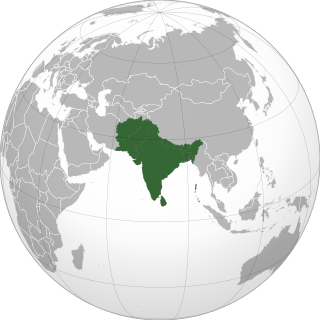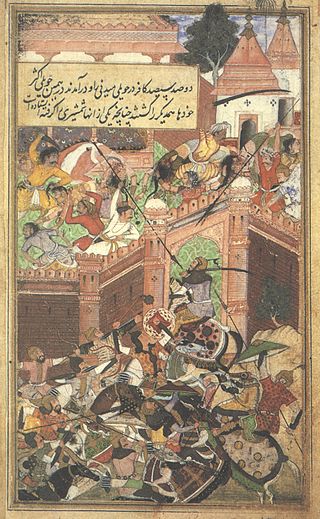
The Muslim period in the Indian subcontinent or Indo-Muslim period is conventionally said to have started in 712, after the conquest of Sindh and Multan by the Umayyad Caliphate under the military command of Muhammad ibn al-Qasim. It began in the Indian subcontinent in the course of a gradual conquest. The perfunctory rule by the Ghaznavids in Punjab was followed by Ghurids, and Sultan Muhammad of Ghor is generally credited with laying the foundation of Muslim rule in Northern India.

The Delhi Sultanate or the Sultanate of Delhi was a late medieval empire primarily based in Delhi that stretched over large parts of the Indian subcontinent, for more than three centuries. The sultanate was established around c. 1206–1211 in the former Ghurid territories in India. The sultanate's history is generally divided into five periods: Mamluk (1206–1290), Khalji (1290–1320), Tughlaq (1320–1414), Sayyid (1414–1451), and Lodi (1451–1526). It covered large swaths of territory in modern-day India, Pakistan, Bangladesh, as well as some parts of southern Nepal.

Sangram Singh I, commonly known as Rana Sanga, was the Rana of Mewar from 1508 to 1528 CE. A member of the Sisodia dynasty, he controlled parts of present-day Rajasthan, Gujarat and Madhya Pradesh with his capital at Chittor. His reign was admired by several of his contemporaries, including the first Mughal Emperor Babur, who described him as the "greatest Indian ruler" of that time. The Mughal historian Abd al-Qadir Badayuni called Sanga the bravest of all Rajputs along with Prithviraj Chauhan also known as Rai Pithaura.
The Sisodia was an Indian royal dynasty belonging to the clan that ruled over the Kingdom of Mewar, in the region of Mewar in Rajasthan. The name of the clan is also transliterated as Sesodia, Shishodia, Sishodia, Shishodya, Sisodya, Sisodiya, Sisodia.

The Lodi dynasty was an Afghan royal family that ruled Sultanate of Delhi from 1451 to 1526. It was the fifth and final dynasty of the Delhi Sultanate, and was founded by Bahlul Khan Lodi when he replaced the Sayyid dynasty.
The Muzaffarid dynasty, also called the Muzaffarids, and sometimes, the Ahmedabad dynasty, was an Indian royal family that ruled the Sultanate of Gujarat in western India from 1391 to 1583. The founder of the dynasty was Zafar Khan who was governor of Gujarat under the Delhi Sultanate. When the Sultanate was weakened by the sacking of Delhi by Timur in 1398, and Zafar Khan took the opportunity to establish himself as sultan of an independent Gujarat. His Grand son, Ahmed Shah I established the capital at Ahmedabad. The dynasty ruled for almost 200 years, until the conquest of Gujarat by the Mughal Empire in 1572. The sultanate reached its peak of expansion under Mahmud Begada, reaching east into Malwa and west to the Gulf of Kutch.

The Khalji or Khilji dynasty was a Turco-Afghan dynasty that ruled the Delhi Sultanate for three decades between 1290 and 1320. It was the second dynasty to rule the Delhi Sultanate which covered large swaths of the Indian subcontinent. It was founded by Jalal ud din Firuz Khalji.

Medieval India refers to a long period of post-classical history of the Indian subcontinent between the "ancient period" and "modern period". It is usually regarded as running approximately from the break-up of the Gupta Empire in the 6th century CE to the start of the early modern period in 1526 with the start of the Mughal Empire, although some historians regard it as both starting and finishing later than these points. The medieval period is itself subdivided into the early medieval and late medieval eras.
Raja Shiladitya Tomar, also called Silhadi Tomar, was a chieftain of northeast Malwa in the early decades of 16th century India. He become vassal of Sanga of Mewar and remain as an ally and Sanga helped him and Medini Rai in various battles and in conquering Malwa from Sultans.

Dilawar Khan was a governor of the Malwa province of Central India appointed by the Delhi Sultan in 1392 and he later became the first Sultan of the Malwa Sultanate during the decline of the Delhi Sultanate. After serving at the court in Delhi, he was appointed governor at Dhar in A.H. 793/C.E. 1390–91. Dilawar Khan took the title of 'Amid Shāh Dā'ūd and caused the khutba to be read in his name in A.H. 804/C.E. 1401–02, declaring himself independent and establishing the Malwa Sultanate. He passed his kingdom – the Malwa Sultanate – to his son Hoshang Shah upon his death in A.H. 809/C.E. 1406.

Chittorgarh, also known as Chittod Fort, is one of the largest forts in India. It is a UNESCO World Heritage Site. The fort was the capital of Mewar and is located in the present-day city of Chittorgarh. It sprawls over a hill 180 m (590.6 ft) in height spread over an area of 280 ha above the plains of the valley drained by the Berach River. The fort covers 65 historic structures, which include four palaces, 19 large temples, 20 large water bodies, 4 memorials and a few victory towers.

The Malwa Sultanate was a late medieval kingdom in the Malwa region, covering the present day Indian states of Madhya Pradesh and south-eastern Rajasthan from 1401 to 1562. It was founded by Dilawar Khan, who following Timur's invasion and the disintegration of the Delhi Sultanate, in 1401, made Malwa an independent realm.

The Gujarat Sultanate or Sultanate of Guzerat was a late medieval Islamic Indian kingdom in Western India, primarily in the present-day state of Gujarat. The kingdom was established in 1394 when Muzaffar Shah I, the Governor of Gujarat, declared independence from the Tughlaq dynasty of Delhi.

The Kingdom of Mewar was an independent kingdom that existed in the Rajputana region of the Indian subcontinent and later became a dominant state in medieval India. The kingdom was initially founded and ruled by the Guhila dynasty followed by the Sisodiya Dynasty. The kingdom came to be known as the Udaipur State after it became a princely state in the nineteenth century.

The Battle of Chanderi or Siege of Chanderi took place in the aftermath of the Battle of Khanwa in which the Mughal Emperor Babur had defeated the Rajput Confederacy and firmly establish Mughal rule while crushing regrowing Rajput powers as the battle was fought for supremacy of Northern India between Rajputs and Mughals. On receiving news that Rana Sanga had renewed war preparations to renew the conflict with him, Babur decided to isolate the Rana by inflicting a military defeat on one of his vassals Medini Rai who was the ruler of Malwa. Consequently, in December 1527, taking a circumlocutious route Babur marched to the fortress of Chanderi in Malwa which was the capital of the kingdom of Malwa. Upon reaching Chanderi, on 20 January 1528, Babur offered Shamsabad to Medini Rai in exchange for Chanderi as a peace overture but the offer was rejected by Rai.

Medini Rai was a vassal of Sisodia king Rana Sanga. He ruled much of the Malwa under the lordship of Rana Sanga, who helped him in defeating Sultan of Malwa and conquering Malwa, Chanderi was his capital.
The Khalji dynasty was the first Muslim dynasty to rule the Bengal region in the Indian subcontinent. The dynasty, which hailed from the Garmsir region of present-day Afghanistan, was founded in 1204 by Muhammad Bakhtiyar Khalji, a Muslim Turko-Afghan general of the Ghurid Empire. The Khaljis initially pledged allegiance to Sultan Muhammad of Ghor until his death in 1206, though their rule in Bengal was mostly independent. Under the rule of Iwaz Khalji, Bengal experienced major developments such as its first naval force, flood defence systems and linkage with the Grand Trunk Road. The dynasty was based in the city of Lakhnauti in northern Bengal, later expanding eastwards and southwards. Nasiruddin Mahmud, the son of Mamluk sultan Iltutmish of Delhi managed to conquer Bengal in 1227; although the Khaljis briefly reasserted their independence, they surrendered to the Mamluks in 1231, who replaced them with a series of regional governors.

The Mewar–Malwa conflicts were a series of wars between the Kingdom of Mewar and the Sultanate of Malwa. The conflict erupted due to mutual territorial expansion triggered by both sides on each other. The war was fought in the modern-day regions of Rajasthan and Madhya Pradesh. The Rana branch of the Guhilas, following their successful recovery of the Rajput stronghold of Chittorgarh and the entire region of Mewar alongside Rajputana after the Battle of Singoli, embarked on an ambitious expansion at the cost of their neighbouring kingdoms. On the other side, with the invasion of Timur, the Delhi Sultanate grew weak and many of its provinces gained independence which included Malwa, adjacent to Mewar.













